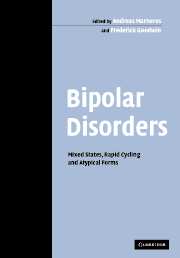Book contents
- Frontmatter
- Contents
- List of contributors
- Preface
- 1 Bipolar disorders beyond major depression and euphoric mania
- 2 Emerging concepts of mixed states: a longitudinal perspective
- 3 Rapid-cycling bipolar disorder
- 4 Bipolar I and bipolar II: a dichotomy?
- 5 Recurrent brief depression as an indicator of severe mood disorders
- 6 Atypical depression and its relation to bipolar spectrum
- 7 Agitated depression: spontaneous and induced
- 8 Schizoaffective mixed states
- 9 Acute and transient psychotic disorder: an atypical bipolar disorder?
- 10 Bipolar disorder in children and adolescents
- 11 Atypical features of bipolarity in old age
- 12 Comorbidity in mixed states and rapid-cycling forms of bipolar disorders
- 13 Challenges in the genetics of bipolar disorder
- 14 Biological aspects of rapid-cycling and mixed states
- 15 The treatment of bipolar mixed states
- 16 The use of atypical antipsychotic agents in the treatment of diagnostic subgroups of bipolar disorder: mixed and pure states, psychotic and non-psychotic
- 17 Investigational strategies: treatment of rapid cycling, mixed episodes, and atypical bipolar mood disorder
- Index
- References
5 - Recurrent brief depression as an indicator of severe mood disorders
Published online by Cambridge University Press: 10 August 2009
- Frontmatter
- Contents
- List of contributors
- Preface
- 1 Bipolar disorders beyond major depression and euphoric mania
- 2 Emerging concepts of mixed states: a longitudinal perspective
- 3 Rapid-cycling bipolar disorder
- 4 Bipolar I and bipolar II: a dichotomy?
- 5 Recurrent brief depression as an indicator of severe mood disorders
- 6 Atypical depression and its relation to bipolar spectrum
- 7 Agitated depression: spontaneous and induced
- 8 Schizoaffective mixed states
- 9 Acute and transient psychotic disorder: an atypical bipolar disorder?
- 10 Bipolar disorder in children and adolescents
- 11 Atypical features of bipolarity in old age
- 12 Comorbidity in mixed states and rapid-cycling forms of bipolar disorders
- 13 Challenges in the genetics of bipolar disorder
- 14 Biological aspects of rapid-cycling and mixed states
- 15 The treatment of bipolar mixed states
- 16 The use of atypical antipsychotic agents in the treatment of diagnostic subgroups of bipolar disorder: mixed and pure states, psychotic and non-psychotic
- 17 Investigational strategies: treatment of rapid cycling, mixed episodes, and atypical bipolar mood disorder
- Index
- References
Summary
Introduction
Bipolar spectrum
The bipolar spectrum is currently the focus of very intensive research, which is hampered by two interrelated biases, one methodological and one commercial. Epidemiological and clinical research in the field of bipolar disorders deals with disorders/syndromes defined according to the diagnostic manuals and uses methods tailored to them, which are not suitable for assessing subthreshold morbidity (minor and recurrent brief depression, recurrent and brief hypomania). This has significant implications for the differentiation between depression and bipolar disorder. As a consequence, major depressive disorders (MDD) are overdiagnosed and heterogeneous; they include many bipolar II (BP-II) cases, of which the hypomanic component does not reach the Diagnostic and Statistical Manual of Mental Disorders (DSM-IV: American Psychiatric Association, 1994) or ICD-10 Classification of Mental and Behavioural Disorders (World Health Organization, 1992) diagnostic threshold for hypomania. This means that drug trials selecting patients on the basis of an MDD diagnosis are also dealing with heterogeneous groups, which include hidden BP-II subjects prone to switch into hypomania.
Moreover, current bipolar research is biased towards mania and neglects bipolar depression. The large majority of modern treatment studies on mood stabilizers select patients with mania and exclude those with BP-II disorders, although the latter are much more prevalent than the former both in clinical practice and among relatives of bipolar patients. In addition, BP-II patients have traditionally been excluded from drug trials using modern antidepressants.
Keywords
- Type
- Chapter
- Information
- Bipolar DisordersMixed States, Rapid Cycling and Atypical Forms, pp. 109 - 130Publisher: Cambridge University PressPrint publication year: 2005
References
- 1
- Cited by



